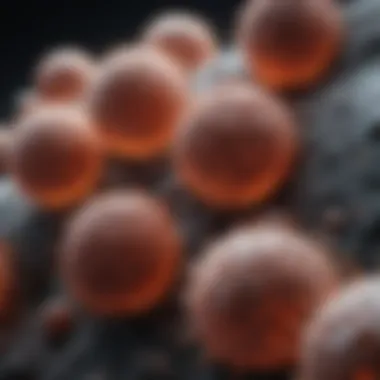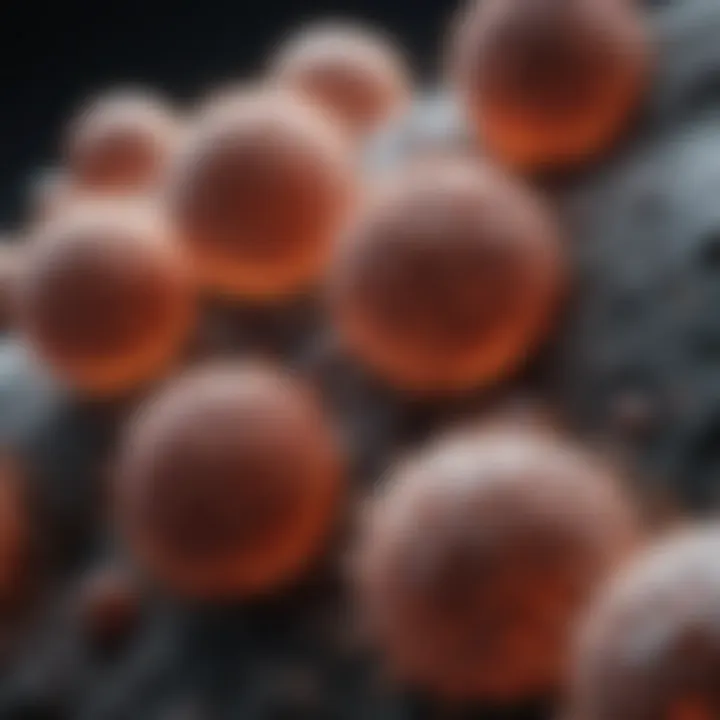Understanding the Early Stages of Melanoma


Intro
As the sun sets on the horizon, casting a warm glow on our skin, it’s easy to forget the lurking dangers that accompany those sun-soaked moments. One such danger is melanoma, a form of skin cancer that often starts without much warning. Understanding this disease from its inception is crucial, as it paves the way for better prevention, diagnosis, and treatment.
This article seeks to shine a light on the early stages of melanoma, dissecting the biological processes behind initial tumor formation. We’ll not only touch on what these processes are but also how they manifest clinically. Recognizing the importance of detecting melanoma early can be the difference between life and death for many.
Research Overview
Summary of Key Findings
Research into the early stages of melanoma has revealed several important insights:
- Melanoma originates from melanocytes, the cells responsible for producing melanin in the skin.
- Changes in the DNA of these cells can lead to uncontrolled growth, resulting in cancer.
- Early clinical presentations include changes in existing moles, new pigmented lesions, or other skin alterations.
- There are various risk factors associated with melanoma, including UV exposure, family history, and skin type.
Importance of the Research
This exploration is not just academic; it holds real-world implications. With late-stage melanoma presenting a costly burden on health systems and devastating effects on individuals, the significance of early detection cannot be overstated. Research helps refine screening guidelines and treatment protocols that can potentially save lives. Understanding melanoma’s beginning stages can lead to informed public health strategies and personal preventative measures.
Methodology
While discussing melanoma, it’s important to touch upon the methods used for gathering insights into this cancer's early stages.
Study Design
Most studies focus on case-control designs, comparing those diagnosed with melanoma against a control group without it. This allows researchers to identify associations with risk factors and clinical presentation.
Data Collection Techniques
Data collection typically involves:
- Surveys and interviews: Gathering information on personal history and habits regarding sun exposure.
- Biopsy samples: Analysing skin tissue to assess genetic changes in melanocytes.
- Longitudinal studies: Following individuals over time to observe mole changes.
These methodologies help create a comprehensive view of how melanoma develops and the warning signs that individuals should look for.
"An ounce of prevention is worth a pound of cure."
By delving deep into the biological and clinical nuances of early-stage melanoma, this article opens a pathway to better management strategies and a proactive stance against this disease.
Foreword to Melanoma
Melanoma represents a significant area of concern within dermatology and oncology, standing as one of the most aggressive forms of skin cancer. Understanding its beginning stages is crucial for early intervention and effective treatment strategies. The primary focus of this section is to cast light on what melanoma is, how it arises, and why an early grasp of its characteristics can make a life-saving difference. This knowledge equips individuals not only with awareness but also encourages proactive healthcare measures.
Definition of Melanoma
Melanoma is a type of skin cancer that develops from melanocytes, the cells responsible for producing melanin, the pigment that gives skin its color. Unlike other skin cancers, melanoma can spread quickly to other parts of the body if not identified early. Early recognition of its specific traits can mean the difference between effective treatment and more advanced, challenging cases. To break it down simply, melanoma often presents itself as a new or changing mole, generally with an irregular shape, mixed colors, and a diameter larger than that of a pencil eraser. Understanding these elements can help individuals recognize potential concerns at a glance, prompting timely examination and intervention.
Epidemiology of Melanoma
The epidemiology of melanoma reveals crucial details about its prevalence and incidences. Statistics show that melanoma is among the fastest-growing cancers globally. In the United States alone, it's estimated that more than 106,000 new cases will be diagnosed in 2021, and the rates keep climbing. This rising trend is linked to environmental factors, particularly ultraviolet (UV) radiation from the sun and tanning beds.
Environmental factors are not the only influencers; genetic predispositions play a major role as well. Families with a history of melanoma demonstrate a higher incidence of the disease, suggesting a hereditary component that cannot be overlooked.
"Awareness is the first step in prevention".
A burgeoning population of young adults, particularly women aged 15-29, shows alarming increases in melanoma diagnosis, emphasizing the urgent need for enhanced prevention strategies. This demographic shift underscores the propensity for melanoma to strike at a younger age, shifting the conversation around routine skin checks from older generations to younger ones.
In summary, this section will lay the foundation for understanding how melanoma develops and grows. By familiarizing ourselves with these meanings and the statistics surrounding this form of cancer, we can foster a more informed dialogue regarding prevention, early detection, and the overall management of melanoma.
Understanding Skin Anatomy
Understanding skin anatomy is critical when talking about melanoma, the notorious skin cancer. Knowing the various skin layers and their functions can shed light on how melanoma begins and progresses. This knowledge, in turn, might help in detecting the disease early and formulating effective treatment strategies. From the protective properties of the skin to the pivotal role of its layers in the development of melanoma, understanding these aspects are integral for students, researchers, and healthcare professionals alike.
Layers of the Skin
The skin consists of three main layers: the epithelium, the dermis, and the subcutaneous tissue. Each layer has unique characteristics that play a substantial role in overall skin health and function.
Epithelium
- The epithelium, being the outermost layer, acts as the first line of defense against environmental aggressors. This barrier prevents pathogens and harmful substances from penetrating deeper layers.
- One key characteristic of the epithelium is its ability to regenerate quickly after injury, owing to its high cellular turnover. This is particularly significant in contexts such as chronic wounds where rapid healing is essential.
- A unique feature of this layer is the presence of melanocytes—cells that produce melanin. This pigment serves as a natural sunscreen by absorbing UV radiation and protecting against DNA damage, an essential function in the context of melanoma.
- However, the rapid regeneration of epithelial cells can also be a double-edged sword. In cases of excessive UV exposure, abnormal growth may occur, which can lead to the onset of melanoma.
Dermis
- The dermis lies just beneath the epithelium and is known for its structural support and nourishment to the epidermis above. It contains vital components such as blood vessels, nerves, and connective tissues.
- A significant characteristic of the dermis is that it houses various types of cells, including fibroblasts and immune cells, which play a role in wound healing and defense.
- What makes the dermis interesting is its response to changes in the body, including inflammation and repair processes. This adaptability can influence how melanoma might react to treatment, highlighting the relevance of dermal health in this context.
- However, the intricate network present in the dermis makes it susceptible to various conditions, including melanoma, as cells can multiply uncontrollably in the presence of mutation.
Subcutaneous Tissue
- The subcutaneous tissue serves as a cushion to protect underlying structures like muscles and bones. It primarily consists of fat and connective tissue, resulting in insulation against temperature variations.
- One of its key characteristics is the energy reserve provided by the fat content, which is vital for the body's metabolism.
- A unique aspect of subcutaneous layer fat is that it can influence the distribution of melanoma. For instance, tumors may find pathways within adipose tissue, speeding up the metastasis process.
- Nonetheless, excess fat could be a disadvantage in some instances, as it may provide a suitable environment for tumor growth, amplifying risk factors associated with melanoma.
Functions of the Skin
The skin is not just a shell; it plays several crucial roles:
- Protection from Environmental Threats: It acts as a barrier against pathogens, chemicals, and physical injuries.
- Regulation of Temperature: Through sweating and blood flow adjustments, the skin plays a big part in maintaining body temperature.
- Sensation: The skin contains numerous sensory receptors that allow the body to respond to temperature, pressure, and pain.
- Formation of Vitamin D: Upon exposure to UV light, the skin synthesizes Vitamin D, which is essential for bone health.


Understanding these functions underscores the need for vigilant skin care and monitoring, especially for those at risk of melanoma, as maintaining healthy skin significantly contributes to overall well-being.
In summary, recognizing the skin's anatomy and its multiple functions is fundamental for anyone interested in the early stages of melanoma. The interplay between the skin layers and the potential for mutation enhances the necessity for greater awareness and proactive measures in skin health management.
Pathophysiology of Melanoma
Understanding the pathophysiology of melanoma is key to grasping how this skin cancer begins and develops. This insight lays the groundwork for early detection and effective treatment strategies, which are critical since early intervention can drastically improve outcomes. Melanoma originates in melanocytes, the cells responsible for skin pigmentation. By examining the biological processes at play, we can illuminate the complexities of tumor formation and the factors that contribute to its aggressiveness.
Genetic Mutations in Melanoma
Genetic mutations play a fundamental role in the initiation and progression of melanoma. These alterations disrupt normal cellular processes, leading to uncontrolled growth and survival of malignant cells. The most well-known mutations associated with melanoma include BRAF, NRAS, and various other genetic factors.
BRAF Mutations
BRAF mutations are among the most common genetic alterations found in melanoma patients. This mutation results in the activation of the BRAF protein, which subsequently activates signaling pathways that promote cell proliferation. The key characteristic of BRAF mutations is their prevalence, accounting for about 40-60% of all melanoma cases. This makes it a primary focus in research and treatment. Notably, BRAF inhibitors, like vemurafenib, have shown promise in targeted therapy, significantly improving survival rates in patients with these mutations. However, resistance to treatment can develop, presenting a challenge for continued patient care.
NRAS Mutations
NRAS mutations occur in approximately 15-20% of melanoma cases and also lead to enhanced cell growth. They introduce specific challenges, as therapies targeting NRAS have been less developed compared to BRAF. The unique feature of NRAS mutations is their ability to confer a metastatic nature to the melanoma cells, complicating treatment options. The standard approaches are still evolving, and more research is necessary to develop effective targeted therapies for patients with NRAS mutations.
Other Genetic Factors
Apart from BRAF and NRAS, other genetic factors also contribute to melanoma. For instance, mutations in the CDKN2A gene can increase susceptibility to melanoma. Such mutations disrupt cell cycle regulation, leading to unrestrained cell division. The characteristic of these other mutations is that they often occur in tandem with one of the aforementioned mutations, heightening the risk of disease progression. While these factors may not receive as much attention, they illustrate the multifaceted nature of melanoma's genetic landscape, and they highlight the need for a comprehensive understanding of how diverse mutations influence the disease.
Cellular Dynamics of Melanoma Growth
When melanoma begins to form, it doesn't just grow in a vacuum; it interacts dynamically with its surrounding environment. The cellular microenvironment influences tumor growth, metastasis, and the immune response. Understanding these interactions opens doors to potential therapeutic strategies.
Melanoma cells often employ various mechanisms to evade the body's immune system, including the secretion of immunosuppressive factors that inhibit T-cell activity. Furthermore, tumor-associated macrophages can create a niche that facilitates cancer progression. By dissecting these cellular dynamics, we can explore new avenues for immunotherapy and targeted treatment solutions that aim not just to address the tumor itself, but also to modulate the tumor microenvironment effectively.
"The intersection of genetic factors and cellular dynamics is where the real battle against melanoma takes place, and unraveling these connections is key to more effective treatments."
Ultimately, delving into the pathophysiology of melanoma serves to clarify the intricate web of genetics and biology that governs this disease. Such knowledge not only educates but also equips researchers, clinicians, and patients alike with the insights necessary for fighting melanoma more effectively.
Initial Signs of Melanoma
Recognizing the initial signs of melanoma is critical for the timely intervention and treatment of this potentially deadly skin cancer. Early detection can significantly enhance prognosis, making it crucial for both individuals and healthcare providers to understand the symptoms that may indicate the onset of melanoma.
Melanoma can often begin with seemingly harmless changes in moles or new skin lesions. By familiarizing ourselves with these signs, we can empower ourselves and others to seek medical advice when necessary. Spotting changes early may not only save lives but also reduce the need for extensive treatments down the line.
Asymmetrical Moles
One of the first indicators of melanoma can be found in the shape of moles. Typically, benign moles are symmetrical, meaning that if you were to draw a line through the middle of them, both sides would mirror each other. In contrast, if a mole appears uneven or asymmetrical, this is a red flag.
Individuals should be vigilant about monitoring their moles. If one half doesn’t match the other in size, shape, or color, it warrants a closer look. This may seem trivial, but
Recognizing asymmetry can lead you to seek a professional evaluation sooner rather than later.
Aside from being asymmetrical, it could also be beneficial to be aware of moles that are changing over time in any significant way. Change is always something to keep an eye on.
Color Variation in Lesions
Another major sign of melanoma is the variation in colors present within a mole. A normal mole usually is a single shade of brown, tan, or a similar color. But a lesion displaying multiple colors—think browns, blacks, reds, and even whites—can signal the presence of melanoma. This mix of coloring can appear blotchy or patchy, further emphasizing the abnormal characteristics.
Identifying color variations can sometimes be tricky, but paying attention to how these colors interact within the lesion can be a vital step in early diagnosis. It's important to remember that new hues in existing moles or the emergence of multicolored growths should prompt a consultation with a dermatologist.
Changes in Size and Shape
Changes in size and shape are critical characteristics to monitor in moles or spots on the skin. Typically, a mole larger than 6mm in diameter is worth investigating. While some benign moles can be larger, the key issue is detecting any abrupt change from the usual size.
Moreover, altered shapes can also be a significant signal. If an existing mole appears to be growing or the borders become irregular, this could indicate health concerns. A smoother, rounded border should remain steady in benign moles, while jagged edges can imply malignancy.
It’s not just about how big it gets, but rather how it transforms.
Risk Factors for Melanoma
Understanding the risk factors for melanoma is crucial for identifying individuals who may be more susceptible to this type of skin cancer. This section aims to clarify the elements that contribute to the development of melanoma and to provide insights that can aid in prevention and early detection strategies. By recognizing personal and environmental risk factors, individuals can take proactive measures to protect their skin and enhance awareness within their communities.
Genetic Predisposition
Genetic factors play a pivotal role in a person’s likelihood of developing melanoma. If someone has a family history of skin cancer, particularly melanoma, their risk increases significantly. Certain inherited genetic mutations, such as those found in the CDKN2A gene, can predispose individuals to malignant melanoma. Although such genetic profiles may not be common, a handful of families exhibit alarmingly high rates of this disease, underscoring the importance of family medical history in evaluating risk.
Moreover, it's not just about having relatives who have been diagnosed; the presence of dysplastic nevi—irregular moles that may indicate a genetic susceptibility—also raises concern. People with numerous dysplastic nevi have a higher chance of developing melanoma than those without. Thus, understanding your genetic background can provide vital information when assessing your risk.
Environmental Influences
Environmental factors are equally crucial in shaping the risk landscape for melanoma. Two major contributors are ultraviolet (UV) radiation and the use of tanning beds. Both can have profound impacts on skin health and the likelihood of melanoma.
UV Radiation
Ultraviolet radiation, primarily from sunlight, is a significant risk factor for melanoma. Notably, UV rays can damage the DNA in skin cells, leading to mutations that promote cancer development. The intensity of sunlight a person is exposed to, particularly during childhood and adolescence, is particularly relevant. People who have had severe sunburns, especially in early life, are at a higher risk of developing melanoma later on.
A key characteristic of UV radiation is that it can penetrate the skin and cause cellular damage without the immediate visibility that comes with a sunburn. This invisible risk makes it a particularly dangerous factor since people may underestimate their exposure.
The information highlights the importance of protective measures, such as wearing sunscreen and protective clothing, to mitigate the risks associated with UV exposure. Sun safety should be emphasized during peak sun hours—from 10 a.m. to 4 p.m.—when rays are strongest.


Tanning Beds
Tanning beds are another important environmental influence contributing to melanoma risk. These devices emit UVA rays, which can penetrate deeper into the skin and cause significant cellular damage. Many may view tanning beds as a safer alternative to sunbathing, but studies indicate that regular use significantly increases melanoma risk, particularly in young women.
A key characteristic of tanning beds is that they deliver concentrated doses of UV radiation in a controlled environment, but this control does not lessen the dangers. Users often underestimate the harmful impact they can have, believing that the aesthetic outcomes outweigh the health risks.
Using tanning beds has unique features that make them particularly concerning—people often use them at a frequency that exposes them to high levels of radiation. The cumulative effect can lead to mutations in skin genes, thus enhancing the likelihood of melanoma development.
"It's crucial to understand that while tanning might provide a temporary cosmetic benefit, the long-term consequences can be severe, including an elevated risk for melanoma."
In summary, both genetic predisposition and environmental influences, particularly UV radiation and tanning beds, are significant risk factors for melanoma. By understanding and acknowledging these factors, individuals can take steps to safeguard their skin and encourage informed discussions surrounding the prevention of this serious disease.
Diagnostic Approaches
Clinical Examination Techniques
When it comes to diagnosing melanoma, the first line of defense is a careful clinical examination performed by a healthcare professional. The physician will typically start by taking a detailed history of the patient, focusing on risk factors such as family history of skin cancer, previous skin lesions, or significant sun exposure. Following the history, a physical exam is conducted, often focusing on visible moles or skin lesions.
A methodical approach is taken, often utilizing the ABCDE rule:
- Asymmetry: Irregularity in shape.
- Border: Uneven, scalloped, or notched edges.
- Color: Variation in color across the mole.
- Diameter: Larger than 6mm.
- Evolving: Any change in size, shape, or color.
Informative visual aids, like dermatoscopes, may be employed during this process to magnify and illuminate skin details that could give critical clues toward early melanoma detection.
Biopsy Procedures
If during the examination there’s a strong suspicion of melanoma, the next step typically involves a biopsy. This is crucial in providing a definitive diagnosis. There are several biopsy techniques, each offering unique benefits and drawbacks, which cater to different lesions and circumstances.
Excisional Biopsy
Excisional biopsy involves the surgical removal of the entire mole or suspicious area along with a margin of surrounding skin. This procedure is often considered the gold standard in melanoma detection because it not only aids in diagnosis but also can remove potential cancerous tissue in one go.
A key characteristic of excisional biopsy is its thoroughness. Well, you might say it’s like hitting two birds with one stone. The tissue can be examined histologically to confirm melanoma while also providing potential treatment by removing the lesion. Its effectiveness in diagnosing and managing early-stage melanoma is one of the primary reasons why it’s frequently recommended. However, the procedure does come with limitations, such as the need for local anesthesia and potential scarring, which should be discussed with patients prior to the operation.
Punch Biopsy
Contrasting with excisional methods, a punch biopsy entails using a specialized tool to remove a cylindrical section of skin, often capturing deeper layers as well. This approach can be seen as a middle ground: less invasive compared to an excisional biopsy while still acquiring valuable tissue samples.
The key characteristic here is that it’s generally quicker with less recovery time, which is appealing to both patients and healthcare providers. It can effectively confirm diagnosis while being less disruptive. On the downside, it may be less effective if the lesion extends beyond the punched area, which could lead to incomplete analysis and subsequent treatments.
Shave Biopsy
Shave biopsy is another method that involves removing a thin slice of skin at the surface and may not capture deeper tissues where the melanoma might have spread. This technique is mostly employed for superficial lesions that are suspected of being non-invasive.
The simplicity of this procedure often makes it a popular choice for quick assessments. The key aspect is that it's generally done without suturing, leading to quicker wound healing. Yet, the risk here lies in potential inability to assess deeper cancerous cells, which could result in a false sense of security and later complications if further treatment becomes necessary.
"Understanding the approaches to diagnose melanoma is paramount. Early detection is closely tied to better prognoses and options for treatment."
Each of these diagnostic techniques lends itself to unique advantages and considerations. Knowing when to choose one over another is integral not just for clinical practitioners but also for patients seeking clarity in their health journeys. The right approach can be pivotal in catching melanoma at a stage where intervention can be most effective.
Staging of Melanoma
Staging of melanoma is a crucial aspect of understanding how the disease progresses and impacts treatment decisions. It provides a systematic method to classify the cancer based on its size, depth of invasion, and whether it has spread to nearby lymph nodes or distant sites. In essence, staging helps to outline the battlefield, allowing healthcare providers to devise a tailored approach for management and intervention.
Understanding the stages can empower both patients and practitioners in making informed choices. Early-stage melanoma often leads to better outcomes, while advanced stages may involve more complex treatments.
AJCC Staging System
The American Joint Committee on Cancer (AJCC) developed a well-respected staging system for melanoma, which is widely used in clinical practice. This system employs a classification structure based on three major components:
- Tumor (T): This describes the thickness, ulceration, and extent of invasion of the primary tumor. The higher the T value, the more serious the tumor's characteristics.
- Nodes (N): This pertains to whether regional lymph nodes are involved. Increased involvement can significantly affect treatment and prognosis.
- Metastasis (M): This indicates if the cancer has spread to distant parts of the body.
The AJCC system organizes these components into stage groups, from Stage 0 (in situ) to Stage IV (advanced disease). The categorization is vital as it directly correlates with prognosis and treatment strategies.
"The absence of early detection can make a world of difference; understanding staging offers not just hope but clarity in navigating treatment options."
Importance of Staging
Staging serves manifold purposes in the journey of melanoma care:
- Determining Treatment Plans: The stage informs the medical team about how aggressive the treatment needs to be. For instance, localized melanoma may only require surgical excision, while more advanced stages could necessitate systemic therapies, such as immunotherapy or targeted therapy.
- Prognostic Significance: Each stage of melanoma has a specific prognosis. Early-stage melanoma often boasts a high survival rate, while the odds decrease considerably in higher stages due to metastasis. Awareness of this helps clinicians provide a more accurate outlook regarding treatment efficacy.
- Research and Clinical Trials: Staging is essential in the context of research, particularly for enrolling patients in clinical trials. Most trials are specific to certain stages to evaluate the efficacy of novel treatments.
- Patient Education and Involvement: Knowledge of staging empowers patients to engage actively in their care. They can familiarize themselves with their condition, ask informed questions, and participate in shared decision-making regarding their treatment options.
In summary, staging of melanoma is not merely a diagnostic tool; it is foundational in guiding treatment, predicting outcomes, and enhancing patient involvement in the healing process.
Treatment Modalities for Early Melanoma
When it comes to melanoma, addressing it in its initial stages can be a game changer. The treatment modalities available play a crucial role in determining the long-term outcomes for patients. This section discusses the various methods employed in managing early melanoma, emphasizing both their benefits and considerations.
Surgical Options
Surgical intervention typically serves as the frontline approach for early-stage melanoma. The primary goal of surgery is to excise the cancerous tissue while preserving as much surrounding healthy skin as possible. This procedure not only removes the tumor itself but also helps in staging the cancer, which is vital for subsequent management steps.
- Excisional Surgery: This is commonly performed when melanoma is detected at an early stage. The surgeon will remove the melanoma along with a margin of normal skin. It's a straightforward approach that is often curative for localized melanoma.
- Mohs Surgery: In cases where the melanoma is in cosmetically sensitive areas—like the face—Mohs surgery is preferred. This technique involves removing the tumor layer by layer and examining each layer during the procedure until no trace of cancerous cells remains.
- Sentinel Lymph Node Biopsy: If there’s a suspicion that the cancer has begun spreading, this procedure may be performed alongside excisional surgery. It involves removing the first few lymph nodes to which cancer cells are likely to spread, allowing for an accurate assessment of cancer progression.


Adjuvant Therapies
In addition to surgical options, adjuvant therapies significantly contribute to the management of early melanoma, particularly in reducing the risk of recurrence. These therapies are typically applied following surgery.
Immunotherapy
Immunotherapy stands out as a revolutionary approach in melanoma treatment. It enhances the body’s immune system to recognize and attack cancer cells more effectively.
- Key Characteristic: It works by using natural substances or laboratory-made drugs to stimulate or restore your immune system's ability to fight the disease. This is particularly significant in a disease like melanoma, where the immune response can be a decisive factor in controlling growth and recurrence.
- Benefits: Immunotherapies like checkpoint inhibitors (e.g., pembrolizumab and nivolumab) have shown promising results in increasing survival rates in melanoma patients. They can lead to long-lasting responses, which is preferred in the battle against recurrent melanoma.
- Unique Feature: A notable aspect of immunotherapy is its ability to create an immune memory, meaning that even after treatment has ended, the immune system remains on high alert for any returning cancer cells.
- Considerations: However, immunotherapy isn’t without its challenges. It can cause immune-related side effects, and not every patient responds to this treatment. Thus, careful assessment and monitoring are crucial during the therapy.
Targeted Therapy
Targeted therapy is another advanced treatment option aimed at specific genetic mutations in melanoma cells. This strategy is particularly effective for melanomas with BRAF mutations.
- Key Characteristic: The main idea is to attack cancer cells while sparing normal cells, which can lead to fewer side effects compared to traditional chemotherapies.
- Benefits: Medications like vemurafenib and dabrafenib target the mutated BRAF protein, halting the growth of melanoma and, in some cases, leading to a significant shrinkage of tumors in early stages.
- Unique Feature: Targeted therapy can be tailored to an individual’s genetic makeup, making it a precision medicine approach that has reshaped treatment options.
- Considerations: Despite its efficacy, there’s a risk of developing resistance to targeted therapy over time. Continuous monitoring and adjustments in treatment plans may be necessary as the condition evolves.
Both immunotherapy and targeted therapy demonstrate how far cancer treatment has come, yet they require a meticulous approach to adapt to individual patient needs.
In summary, early melanoma treatment is a multi-faceted approach that combines surgical techniques with newer adjuvant therapies to enhance recovery and reduce the likelihood of recurrence. Careful selection of these modalities based on the patient’s unique situation significantly contributes to better outcomes.
Preventive Measures
Understanding preventive measures is crucial in tackling melanoma, especially in its early stages. These measures not only help in reducing the risk of developing melanoma but also educate individuals on how to recognize potential threats early. Prevention encapsulates various strategies that empower individuals, allowing them to take an active role in their skin health. By making informed choices and becoming more vigilant, one can significantly decrease the chances of encountering this serious form of cancer.
Skin Protection Practices
To effectively shield ourselves from melanoma, practicing robust skin protection is non-negotiable. Here are some essential elements to consider:
- Sunscreen Usage: Selecting a broad-spectrum sunscreen with at least SPF 30 can work wonders in blocking harmful UV rays. Reapplying every two hours—or more often if swimming or perspiring—is vital. No one wants to end up looking like a lobster after a day at the beach.
- Protective Clothing: Wearing long-sleeved shirts, wide-brimmed hats, and UV-blocking sunglasses can act as physical barriers between your skin and the sun's rays. It’s like giving your skin an armor!
- Seeking Shade: During peak sun hours (10 a.m. to 4 p.m.), seeking shade is an easy way to minimize sun exposure. If you can't find shade, creating your own—or finding an umbrella—can be a lifesaver.
- Avoid Tanning Beds: The allure of a quick tan often overshadows the risks involved. Tanning beds emit UV radiation, which can cause skin damage and increase the likelihood of melanoma. It’s better to embrace your natural skin tone.
In the grand scheme of skin health, adopting these preventive measures can significantly decrease one's risk of melanoma. The importance of self-care and being proactive cannot be stressed enough.
Regular Skin Screenings
Consistent skin screenings serve as a barometer for skin health, playing a fundamental role in the early detection of melanoma. Here’s why regular skin screenings can prove invaluable:
- Early Detection: The sooner melanoma is caught, the better the treatment outcomes. Regular check-ups increase the possibility of catching changes in moles or new growths before they escalate.
- Professional Insight: Dermatologists are trained to spot anomalies that might escape a layperson's eye. Their expertise can help dispel any uncertainty and offer peace of mind.
- Self-Examination Techniques: In between professional screenings, individuals should perform self-examinations. Familiarizing oneself with the existing moles and noting changes can help in spotting trouble sooner rather than later. Remember the ABCDE rule of moles: Asymmetry, Border, Color, Diameter, and Evolving. Keeping these traits in mind can guide a person toward an informed approach to skin monitoring.
"An ounce of prevention is worth a pound of cure."
Regular screenings not only benefit the individual but also contribute to a broader awareness regarding skin health across communities. It fosters an environment in which individuals prioritize their skin’s well-being, encouraging discussions about health practices and promoting collective vigilance in combatting melanoma.
Future Research Directions
The exploration of melanoma does not stop at understanding its current phases; the future beckons with countless possibilities in both treatment and diagnosis. As researchers dig into the complexities of this disease, their focus is not just on surviving but thriving—improving the quality of life for patients even with a diagnosis of melanoma. The importance of this section lies in identifying emerging trends and advancements that can deepen our understanding of this cancer and ultimately lead to better outcomes.
Emerging Therapies
The quest for effective treatments has led to a surge in innovation. New therapies that harness the body's immune system, such as different forms of immunotherapy, are showing promise. Checkpoint inhibitors, like pembrolizumab and nivolumab, can significantly slow tumor progression in advanced stages of melanoma.
Moreover, researchers are investigating the potential of personalized medicine, which tailors treatments based on individual genetic makeup. Such approaches can lead to more effective and targeted therapies while minimizing side effects. For example:
- Targeted therapies: These focus on specific genetic aberrations found within melanoma cells, leading to drugs that directly attack tumors at their core.
- Combination therapies: By using two or more treatment strategies together, researchers aim to enhance effectiveness and counteract resistance that tumors might develop.
This forward-looking research not only aims to create new therapies but also to maximize the benefits of existing ones through better patient stratification and robust clinical trials, emphasizing the need for ongoing research initiatives and funding.
Role of Technology in Diagnosis
In today's world, technology isn't just a tool; it is a game-changer in diagnosing illnesses like melanoma. Digital health solutions, such as artificial intelligence, are revolutionizing how clinicians identify potential melanoma cases. Advanced algorithms are developed to analyze skin images with remarkable accuracy, often outperforming human specialists.
Some pivotal advancements include:
- Teledermatology: Provides remote consultations, allowing for swift diagnoses, especially in under-resourced areas. This adds an extra layer of accessibility for patients.
- Wearable devices: Innovations that monitor skin changes in real time could alert users to changes needing immediate attention. This gives a proactive edge to patient care.
- Machine Learning: The use of algorithms to predict the likelihood of melanoma development based on factors from patient data accelerates the diagnostic processes dramatically.
The integration of these technologies not only ensures timely diagnostics but also improves the accuracy in identifying malignant lesions at the earliest stages.
As these technologies evolve, they present broader implications in terms of patient education and empowerment, encouraging individuals to take charge of their skin health.
The future of melanoma research and diagnostics is shaping up to be not only bright but also vastly beneficial. By continuing to push the envelope through external innovations and internal advancements, the hope for more effective treatments and early detection methods grows stronger.
Epilogue
In summary, here are the important points we've traversed:
- The definition of melanoma and its place in skin cancer prevalence.
- A look at skin anatomy and how melanoma develops within it.
- The pathophysiology, highlighting genetic mutations and cellular dynamics.
- The signs one should watch out for, like asymmetrical moles, color variations, and changes in size.
- Risk factors that elevate the chances of developing melanoma, including genetics and environmental influences.
- Diagnostic approaches, emphasizing the significance of timely clinical examinations and various biopsy methods.
- An outline of treatment options for early melanoma, encompassing surgical methods and adjuvant therapies.
- Preventive measures that individuals can take to reduce their risk.
- Potential future research directions that may provide new insights into treatment and diagnosis.
Summation of Key Points
The journey through melanoma's early stages reveals intricate detail about its complex nature. Key takeaways highlight how melanoma not only affects individuals but also society at large. Awareness leads to early detection, which in turn can save lives.
- Early symptoms are often subtle, making vigilance essential for timely medical consultations.
- Personal risk factors and lifestyle choices should guide preventive measures, integrating knowledge into daily habits.
- The ever-evolving treatment landscape encourages ongoing research, pushing the boundaries of what is possible in managing melanoma.
"Understanding melanoma is not solely for the medical professional; it's a vital part of public engagement in health, encouraging proactive behavior toward skin health."
Implications for Public Health
The implications of effectively managing melanoma extend far beyond individual patients. Public health initiatives can play a major role in shaping the overall picture of melanoma prevention and care. Education about the early signs and preventive strategies can empower communities to take charge of their skin health.
- Community awareness programs can enhance understanding of risk factors, particularly among populations at greater risk.
- Access to skin screenings should be prioritized, making it easier for individuals to monitor their skin and seek timely medical advice.
- Policy-making can encourage regulations on UV exposure, such as limits on tanning bed usage and promoting sun safety practices.
As we consolidate our efforts toward melanoma awareness and management, we underscore a collective responsibility—not just from healthcare providers but from the community as a whole, ensuring everyone has the tools needed to combat this prevalent form of skin cancer.



